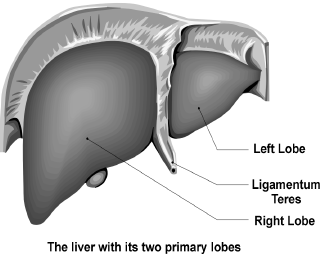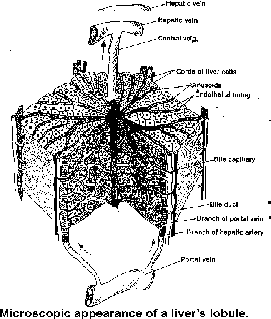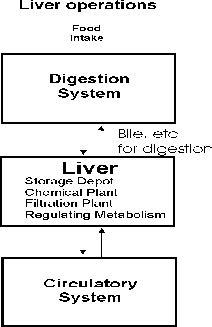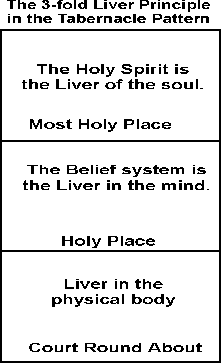THE LIVER AND ITS SPIRITUAL SIGNIFICANCE
By Dr. Lee Warren, B.A., D.D.
© 1997 PLIM REPORT (Jan/Feb97)
See Related Articles: SCIENCE AND MEDICINE
![]()
Introduction
The liver is one of the largest organs in the body, yet it gets very little respect. The brain, heart, and lungs are always described as essential to the bodys health. Without the liver, though, the physical body could not operate.
In general, people do not think about their liver until it malfunctions. Rodney Dangerfield always says: "What does a guy have to do to get some respect around here?" This questions truly applies to the liver and its operations. Since none of its functions can be observed, as the heartbeat, pulse, or respiratory rate, the liver is the last thing people think of or value.
Yet the liver is the link between the digestive and the circulatory systems. Some of the most important functions of the liver follow.
" The liver secretes bile that aids in the digestion of our food; for without it digestion could not take place.
" The liver detoxifies the blood and stores glucose, (i.e., sugar) the chief source of energy for the body.
" The liver acts as storage for numerous vitamins and minerals.
" The liver makes various substances that aid in the clotting of blood.
" The liver regulates the bodys metabolism.
" Finally, the liver regenerates itself.
These are just a few of the more than 500 functions of the liver.
How did ancient civilizations view the liver?
Throughout history, humankind has thought there was something special about the liver of mammals. The Babylonians were the first to use a sheeps liver for divination. Many ancient cultures, from the most advanced to the most primitive, have believed that the liver was the center and the source of life.
The Dictionary of the Bible by James Hastings verifies this. It states the following about the Semitic peoples belief in the liver. "According to Semitic ideas, a peculiar holiness belonged to the liver and kidneys together with the fat attached to them; the reason being that they were regarded as the special seats not only of emotion but of life itself (p. 588)."
Now the Greek word for liver is "hepar" and all things pertaining to the liver are called hepatic. Both the Gentiles and Israel had cultural views about the liver. Ancient cultures failed to understand the reality of the liver because modern science did not exist.
One of the most remarkable things about the liver is its ability to regenerate itself. An ancient Greek myth seemed to revealed this fact before the existence of modern science. In the story of Prometheus, Zeus punished the demi-god for giving humans the knowledge of fire. Zeus chained Prometheus to a rock and made him endure the eternal torture of an eagle eating his liver out every day. His liver would promptly grow back every night. (http://www.arrakis.com.au/ais_users/zan).

What is the intent of this article?
Now various articles in the "PLIM REPORT" have shown that mans physical body is a temple (1 Cor. 6:19-20) and a microcosm. The intent of this article is to explain the spiritual reality of the liver. We will discuss the liver from a psychological and spiritual standpoint by examining the functions of the liver in the physical body (Rom. 1:19-20). This will enable one to see these corresponding functions in the mind. Everyone knows that the mind does not possess a physical liver, but there has to be a liver principle there.
[Note: This article will only explain primarily the functions of the liver. We will provide only a brief description of its structure or anatomy, due to space limitations.]
Does the liver link circulatory and digestive systems?
In order for the body to continue to live, it needs food to provide energy, repair itself, reproduce, and grow. Now the digestion system is designed to perform this function. Its purpose is to extract the essence from the food that we eat and discard the indigestible part as waste. Most of the foods digestion and absorption of the essence takes place in the small intestine, which is the largest part of the digestive tube. Now the essence or nutrients of food, after being broken down, are absorbed directly into the circulatory system or blood stream.
The purpose of the circulatory system is to transport the nutrients along with fresh oxygen to all the cells of the body, so that they may perform various functions for the body.
However, before the blood can return to the heart, it passes though the liver. A brief examination of the livers structure is needed to fully understand its link between the digestive system and the circulatory system.
What is the livers structure?
The liver is an organ that is in all higher forms of life such as birds, reptiles, and mammals. In humans it is the largest and heaviest organ within the body. It weighs over 3- pounds.
Now the liver appears as a spongy, reddish brown organ that lies just below the diaphragm in the abdominal cavity. Structurally, the liver is divided into two parts called the right lobe and left lobe (see diagram on p. 16) by the "ligmentum teres" which is a cross like structures.
This cross like structure symbolically represents the Messiahs crucifixion that divided the Old Testament from the New Testament (see diagram on p. 14 and the article "Do You Know What The New Testament Is?" p. 8). Now the right lobe is also the biggest and it typifies the New Testament where the sons are led by the Spirit (Rom. 8:14). The left lobe represents Israel under the Old Covenant who was led by the Law of Moses. Again there are numerous correlations that can be made with the Messiah and His purpose, but space is limited.
What is the interior structure of the liver?
Now structurally the interior of the liver contains thousands of tall six-sided spaces called lobules (See diagram on pg. 18). Inside the lobules are rows of liver cells that are called hepatic cells. Now these cells in the six-sided lobules are arranged around blood vessels, bile ducts nerves, and lymph vessels. The purpose of these structures will be discussed later in this article.
What is the liver's regeneration capacity?
Now as was mentioned earlier, the liver can regenerate itself. The most amazing thing about the liver is that if a person has two thirds of their liver removed through trauma or surgery, it will grow back to the original size within four weeks. This has great spiritual significance. The soul or mind has great regenerative power unto eternal life through Yahshua the Messiah-the Inner Light also referred to as the Buddha nature by the Buddhist. This shows that a soul can be regenerated without the process of multiple reincarnations.
Does the blood circulate through the liver?
At any one time, as much as 10 percent of all the blood in the body is present in the liver. The liver being such a vascular tissue receives 25% of its blood from the hepatic artery, which carries fresh oxygenated blood to the liver so that it can do its work of processing the substances that arrive from the intestine. The blood from the intestines represent 75% of the livers blood, which the portal vein supplies from the flesh (see diagram on p. 18).
Now the portal vein transports nutrient-rich blood into the liver through a slit called the "porta hepatis" (Latin for "door to the liver", see diagram on p. 18). This blood also includes old red blood cells and hormones from the intestines and the pancreas. The blood leaves the liver by the hepatic veins to a larger main vein, called inferior vena cava, which goes to the heart.

What are the various functions of the liver?
Simply put, the liver is the filtration plant, chemical factory, and storage depot for the body. As blood enters the liver through branches of the portal vein and hepatic artery, it passes through the lobule walls and flows between the rows of liver cells, depositing blood into channels called sinusoids (See diagram on p. 18). Here special scavenger cells trap and devour worn-out red blood cells, bacteria, and other debris.
The liver is the storage depot for much of the bodys material. Blood from the digestive process of the intestines carries excess sugar. The liver cells take up this excess sugar as glucose, and converts it to glycogen for storage.
Whenever the blood sugar levels drops, glycogen is reconverted to glucose and added to the blood. If the liver uses up its full capacity to store glycogen, it converts glucose to fat for storage in fatty tissue. This processed is reversed once the capacity of the liver has returned to normal.
Amino acids, the products of digested proteins, are stored and some are processed into new blood proteins. Vitamins and minerals such as A, D, B-12, and iron, are also stored in the liver and added to the blood as needed.
The liver has yet another transport system to carry bile. This feature is useful to the intestines as an aid in digestion. These are some of the main functions that the liver performs for the body. This article will now proceed to examine how the principles of the liver operate within the mind.
Does the mind need food to develop as the body does?
In previous issues of the "PLIM REPORT" it has been shown that there is an anecdotal relationship between the digestive system of the body and the way the mind operates. Even the Bible correlates the bodys need for food to the minds need for words and thoughts. Moses wrote: "& that man doth not live by bread only, but by every word that proceedeth out of the mouth of Yahweh (the Lord) doth man live (Deut. 8:3)."
Joseph C. Pearce in his classical book The Crack in the Cosmic Egg (© 1971 Washington Square Press) confirms this metaphorical relationship between the mind and body. He states: "As the body must be fed to realize the potential built into the genes as a blueprint waiting development, so must the mind (p. 50)."
Now no one would look for an invisible mind to have a digestive system, a circulatory system, or liver as the body possesses to obtain its proper nutrients from the food. However, the principles of this process must operate within the mind.
What is food for the mind?
Sensory information, ideas, and experiences are food for the mind-brain. It is a known fact in human development that various senses of the brain must have stimuli from the environment for them to develop. If vision is to develop in an infant, the mechanisms of sight (the eyes and various parts of the brain) must receive the proper stimuli and be exercised early. There is also a learned response to what one sees within their environment.
If a stimulus does not exist, vision will not develop. Neural networks must develop in the brain that cause sight to exist. So without stimuli, the brain is basically dead. Likewise, the mind must have this sensory information from the brain to begin to develop and grow.
Now the mind in principle digests, assimilates, and stores various forms of information, the same as the digestive system does.

How does the mind digest?
Psychological digestion differs from the bodys physical digestion in many aspects. Where there are various physical substances acting on food to break it down to it simplest form whereby the body can absorb it, the mind is a total abstraction to most humans. For they know next to nothing about it. All one can say is that one feels, thinks, and perceives through it, but how it operates no one knows.
Although many theories have been put forth, it is not fully understood how the brain digests and assimilates sensory information that causes consciousness to exist. But the understanding of the brains operation is clearer than the functions of the mind.
Many have attributed the digestion and assimilation of the mind to the unconscious. Now the unconscious mind is compared to the physical bodys involuntary nervous system that takes care of all the lifes functions in the body. Simply put, the unconscious mind operates behind the scenes and brings about thinking, feeling etc., that causes consciousness to exist. In much the same fashion the involuntary nervous system causes the physical senses to operate and become conscious of this physical world.
No one fully understands the digestive and assimilation process of the invisible non-material mind. Psychologists know that the cultural belief system directs the attributes of the mind, such as will, reason, imagination, etc., in a certain way. This simply means that the mind operates according to its cultural programming.

What is the importance of the cultural belief system?
According to most psychologists, all the physical senses develop in some cultural context. For example, the cultural programming, not the digestive processes, determines ones physical taste for various foods. Some cultures have a taste for beans and rice, while others are exclusively meat eaters.
Likewise, the belief system determines what ideas and experiences are digested and assimilated in the mind. Mr. Pearce in his book points out that the mind acts with its belief system as an "editorial hierarchy (p. 61)" because it acts as a policy-making mechanism determining what the senses perceive.
Mr. Pearce points out that the patterns or programs of the mind from early childhood determine what shall be coped with. Simply put, our culture determines what will be digested. This programming acts as a filter or screening process allowing only related information in the mind. And it also determines the shape of this new incoming information such that it can be assimilated into the existing belief system.
In short, all human minds initially develop in some cultural context, which conditions or programs the mind. Thus, it is the belief system that dictates how the mind digests, assimilates, and stores all information in the memory.
What is the livers function in the mind?
From the description of the belief system, we see that it resembles the functions of the physical liver in the body on how it directs the mind to receive and process information. As was stated earlier, the liver is the bodys chemical plant, filtration plant for the blood, and storage depot for the body energy. Now the belief system directs the mind to mimic these same operations.
As the liver plays a major role in the digestion of food and its assimilation into the body by the circulatory system, the belief system causes various attributes of the mind, such as reason, intellect, and imagination to digest and assimilate information. Here the belief system acts as both a filtration and chemical plant. It causes the mind to process various ideas and feelings, which bring about new ideas and feelings for the individual, and it acts as filtration plant by screening both good and bad ideas that do not fit our model of reality. So cultures have built-in biases therein.
As the liver prevents too much sugar or glucose from entering the blood stream, there has to be something to prevent too much information from entering our consciousness. In other words, our belief system discriminates between sensory information and allows one to react to it appropriately.
What is the liver on a spiritual level?
On the spiritual level, the mind is unable to interpret certain types of information from a spiritual perspective. For example, the Master spoke in parables to the people of Israel, but they could not understand them. In one instance, He said that unless they ate His flesh and drank His blood, they could not receive eternal life (Jn. 6:48-52).
Now everyone literally heard these words, which was food for their soul, but they could not digest and assimilate them. Simply put, they needed an interpretation of this parable. So the Messiah, who was Elohim (God) in a physical body (Jn. 1:14), is likened unto the liver. He was able to interpret this parable or break it down whereby the people could digest and assimilate it.
Now the liver secretes bile that breaks down various foods. Likewise, the Messiah broke down this parable whereby His disciples could absorb it. Clearly, without the liver the body dies, likewise without the Messiah, a quickening spirit, the soul is dead.
The liver's regenerative capacity reflects the spiritual regenerative nature of the Messiah being the Light or the Buddha nature. This regeneration is of the soul. Now the Messiah told His disciples: "&Verily I say unto you, That ye which have followed me, in the regeneration when the Son of man shall sit in the throne of his glory, ye also shall sit upon twelve thrones, judging the twelve tribes of Israel (Mt. 19:28)." Many of the healings the Messiah performed would fit into the category of regeneration.
The Messiah also fulfilled the other functions of the liver such as the storehouse and detoxification. The Messiah is the storehouse of all spiritual truths, for He told His disciples "&I am the way, the truth, and the life: no man cometh unto the Father, but by me (Jn. 14:6)." The Messiah told His disciples that if they eat any deadly thing it would not kill them (Mk. 16:17-18). By deadly thing, the Messiah meant deadly doctrines full of lies that will kill the soul. This shows forth the detoxification power of the Holy Spirit. Finally, the Holy Spirit regulates our soul's spiritual growth and development.
Do people need help in digesting certain experiences?
Another example shows there are many people that experience forms of psychic or supernatural experiences, such as out-of-body experiences or hearing the voice of Elohim, etc., but are unable to digest or interpret them. Some suffer psychological disorders and others just ignore it and are unable to grow on a psychological and spiritual level from it (see "Idiot Savant," p. 16, in the November/December 1996 "PLIM REPORT" issue).
The Messiah told His disciples that He would give them a comforter that would abide with them forever (Jn. 14:16-17). He told them: "But the Comforter, which is the Holy Ghost, whom the Father will send in my name, he shall teach you all things, and bring all things to your remembrance, whatsoever I have said unto you (John 14:26)." It is the comforter or the Holy Spirit that will enable the mind to absorb many of the spiritual principles that the natural mind cannot assimilate. The liver is the comforter of the physical body, for it regulates all the functions that are paramount to the physiology of the body.
Conclusion
It is hoped that this article has shed some light on the principle of the liver in the physical body. Without a liver, food would be not broken, various chemicals would not be made for the body, the bodys energy would not be stored, nor would the blood be filtered. The liver represents a principle that operates on the physical level, mental or psychological level and spiritual level.
On spiritual level, the Holy Spirit is our spiritual liver, for our natural mind is far to limited as the Messiah pointed out with Israel. For they were unable to understand any of His parables. His disciples became angry at Him for not explaining the parables to Israel. The Master replied: "&Because it is given unto you to know the mysteries of the kingdom of heaven, but to them it is not given (Mat. 13:11)."
Paul wrote the following concerning the ability of Spirit to reveal things unto the mind of man. He states: "For what man knoweth the things of a man, save the spirit of man which is in him? even so the things of Elohim (God) knoweth no man, but the Spirit of Elohim (God). Now we have received, not the spirit of the world, but the spirit which is of Elohim (God); that we might know the things that are freely given to us of Elohim (God). Which things also we speak, not in the words which mans wisdom teacheth, but which the Holy Ghost teacheth; comparing spiritual things with spiritual. But the natural man receiveth not the things of the Spirit of Elohim (God): for they are foolishness unto him: neither can he know them, because they are spiritually discerned (1 Cor 2:11-14)."
Return to the PLIM Report Table of Contents|Home Page|What's New
![]()
© 1997 PLIM, Inc.
![]()